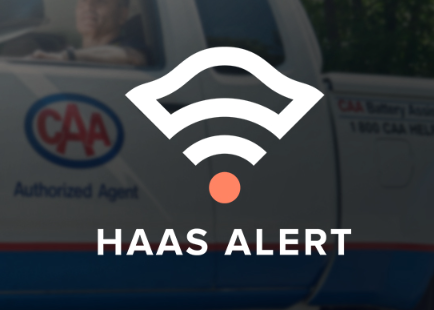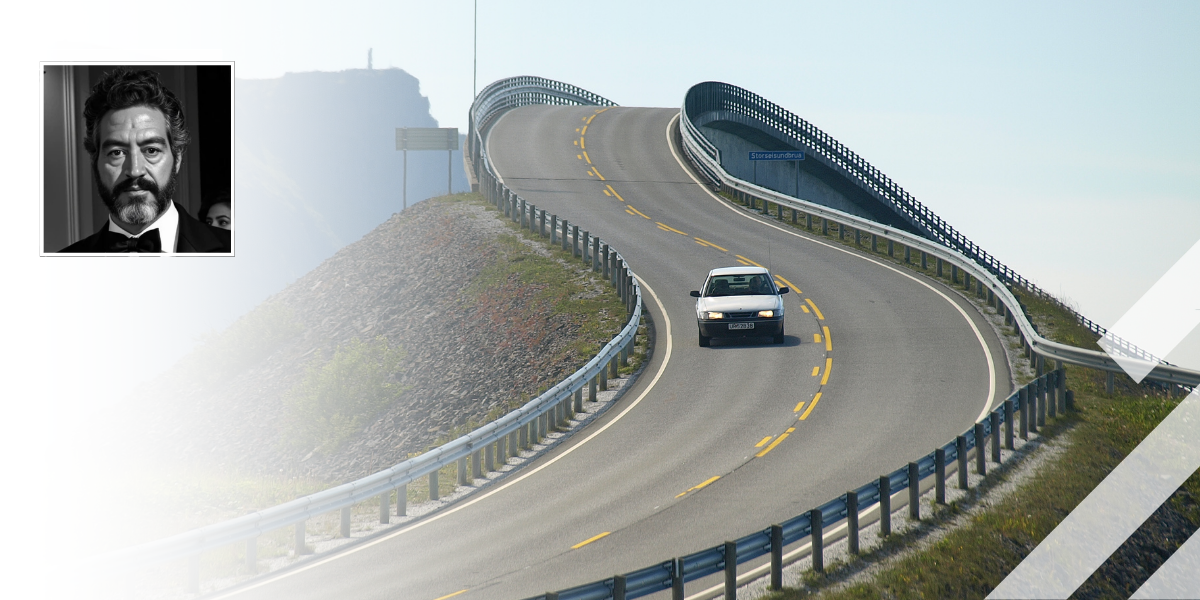A COLLISION-FREE WORLD WHERE EVERYONE GETS HOME SAFELY
In the first of a trio of articles on road safety innovation, Intertraffic gets the ball rolling with HAAS Alert’s Director of Strategy and Business Development for Europe, Gareth Evans.
HAAS Alert's mission is to build lifesaving mobility solutions to make vehicles and roads safer and smarter. The ultimate vision is a connected, collision-free world where everyone gets home safely. That’s some ambition, but this company is doing their utmost to make it a reality.
The Chicago based company aims to make roads and communities safer by delivering real-time digital alerts from emergency response, municipal and private fleets, work zones, and connected infrastructure to nearby drivers through their innovative Safety Cloud®, the world largest commercially deployed CV2X safety solution. In simple terms, it is a collision prevention service.

Road Safety Solutions in the Cloud
Safety Cloud digital alerting notifies drivers through the navigation apps or a vehicle’s infotainment system when they're approaching active roadside incidents and hazards (or if an emergency vehicle is approaching them), providing advance warning up to 30 seconds in advance. Available on millions of vehicles and mobile devices, Safety Cloud digital alerts prevent distracted driving, protect vulnerable road users, and help fleets, cities, and agencies achieve Vision Zero and Safe Systems objectives. So how did it all start? What was the catalyst?
“It started when our founder and CEO, Cory Hohs,” says Gareth, “was on his way to work on a motorcycle and nearly got hit by an ambulance. One of the first ideas that he had was to see if there was a way to increase the audible noise for sirens into a bike helmet. And here we are.”
"Our founder was on his way to work on a motorcycle and nearly got hit by an ambulance. One of the first ideas that he had was to see if there was a way to increase the audible noise for sirens into a bike helmet"
“We live in a world where people are so distracted,” he continues. “Vehicles are designed so you're in your own personal bubble, have high-quality noise blocking insulation, and people are more distracted than ever. When Cory and the rest of the co-founders really started to look into this in the US, they saw that there's a huge problem with emergency service personnel, or first responders, getting killed or seriously injured at the side of the road.”
Evans and his HAAS Alert colleagues in the UK and US have distilled what they do into a convenient sentence: interrupting the distracted driver and get their attention on the road, giving them a clear indication of what is coming up ahead or even behind.
“We see on two sides of the road safety element,” Gareth explains. “It's helping and supporting the men and women that are operating on the road, and then also the general public as well. We're doing some projects in the United States with wrong way driving alerts, actually alerting someone that there's a wrong way driver heading in their direction.”
The All-Important Half-Minute
“What we aren't there for is that last minute decision that a vehicle needs to make. So we're not a typical ADAS system. The alerts are there to give someone that 15-30 seconds heads up in advance that there is ‘x’ up ahead or there is ‘y’ coming behind you, so they can adjust their driving behaviour, or at least pay attention and be more focused in those really important 30 seconds.”
The obvious question now is the simplest of all: how does it work? How does the message or the alert get to the driver, and what does the driver hear or see?
“Data reaches Safety Cloud in a few different ways. We have our own transponder-based hardware that we can put into an emergency service vehicle, etc, which is what we call HA-7. Or we can integrate with partners such as telematics companies, partners that are already connected in some emergency vehicles,” he says. “We also take trusted data feeds, for example, from National Highways Digital Lab in the UK and we're tapping into the NAPCORE data and members of Data for Road Safety (DFRS). The data comes into our Safety Cloud platform and what we are doing, although it sounds very simple, is actually really complex, we are calculating and determining in real time, what and where those alerts are by the data feeds that we receive, categorising and delivering packaged alerts directly to the car manufacturers and navigation providers.”
"The data comes into our Safety Cloud platform and what we are doing, is calculating and determining in real time, what and where those alerts are by the data feeds that we receive, categorising and delivering packaged alerts directly to the car manufacturers and navigation providers"

The Pure Mathematics of Road Safety
However, the HAAS Alert approach to road safety and, ultimately, saving lives, goes even deeper, as Gareth elucidates.
“We make a very conscious decision to describe ourselves as a safety company not a technology company. We want to make it easily relatable and simple to everyone we are trying to project on the road. But we do very complex stuff and hard work to make it simple for car manufacturers to put an alert in their vehicle. We are not just collecting data and sending it to the OEM, this is not what they want to deal with. The OEMs are challenged, because globally, they've got different data feeds, different data formats, different priorities and different political pressures. Safety Cloud gives them the mechanism to produce alerts in their vehicles, anywhere in the world. Meaning they don’t need one approach in Europe (and even then individual counties in Europe), and USA, and so on.”
"The OEMs are challenged, because globally, they've got different data feeds, different data formats, different priorities and different political pressures. Safety Cloud gives them the mechanism to produce alerts in their vehicles, anywhere in the world."
Alert Status: Red
“We’re currently live with Volkswagen, Stellantis and Škoda, with more automakers adopting Safety Cloud. For enabled cars, whether you have got your navigation on or not, you would get an alert in the vehicle. Digital alerts are shared over infotainment, instrument or head up display with a small visual and audio prompt. How this actually appears in a vehicle is very much dependent on the OEMs and also their capability.”

"Just because there's lots of data, doesn't mean it's always good data, especially for pre-emptive safety"
Says Gareth: “There’s not necessarily a data volume issue when it comes to safety. There's data everywhere, just look at the national access points, DFRS, traffic management centres and so on. But, just because there's lots of data, doesn't mean it's always good data, especially for pre-emptive safety. One of our first priorities is to work out if can we be connected directly to the asset that might be generating a hazard on the roadway. Being directly connected to an active ambulance, a fire truck, police car, tow truck, work zone vehicle, or even a broken down vehicle through E-call is often much more effective. Because what that does, it takes away all ambiguity. We know exactly where the hazard or person we are trying to project is, and we know situation and to alert or not. Does it have its blue lights and sirens going? We can also feed that back in to the national access points, DFRS, traffic management centres etc to increase data accuracy and use cases.
Visitors to Intertraffic Amsterdam in March will have opportunity to hear the HAAS Alert point of view when the company presents its paper: “30 seconds to Safer Roads for Everybody: Responder-Activated Alerts for Proactive Driver Response”.
Share your story
Do you have an innovation, research results or an other interesting topic you would like to share with the professionals in the infrastructure, traffic management, safety, smart mobility and parking industry? The Intertraffic website and social media channels are a great platform to showcase your stories!
Please contact our Sr Brand Marketing Manager Carola Jansen-Young.
Are you an Intertraffic exhibitor?
Make sure you add your latest press releases to your Company Profile in the Exhibitor Portal for free exposure.

La IA Revoluciona la Industria del Transporte de Carga en México: Ahorro de Combustible, Mayor Productividad y Seguridad Vial
02 January 2025

5 minutos con… Arturo Cervantes: Impulsando la Seguridad Vial en México
28 November 2024

Reforma de Seguridad Vial en Chile: Invirtiendo la Tendencia con Políticas Inteligentes y Tecnología para una América Latina más Segura
28 November 2024
Get up to speed on the mobility industry - our newsletter straight to your inbox!
.png?h=400&iar=0&w=1400)